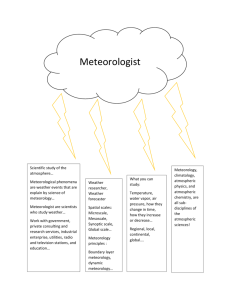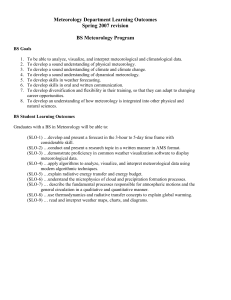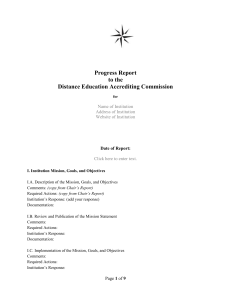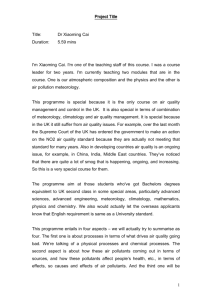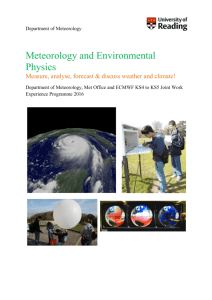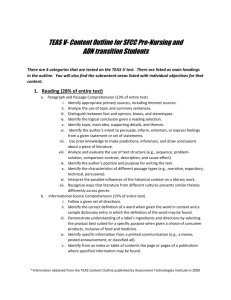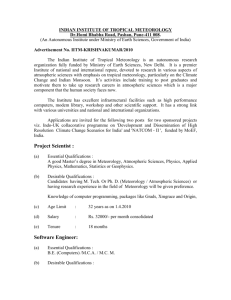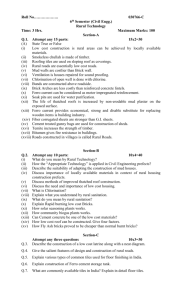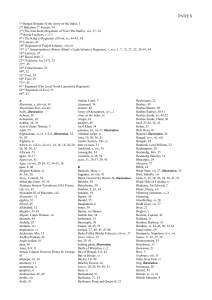Meteorology
advertisement
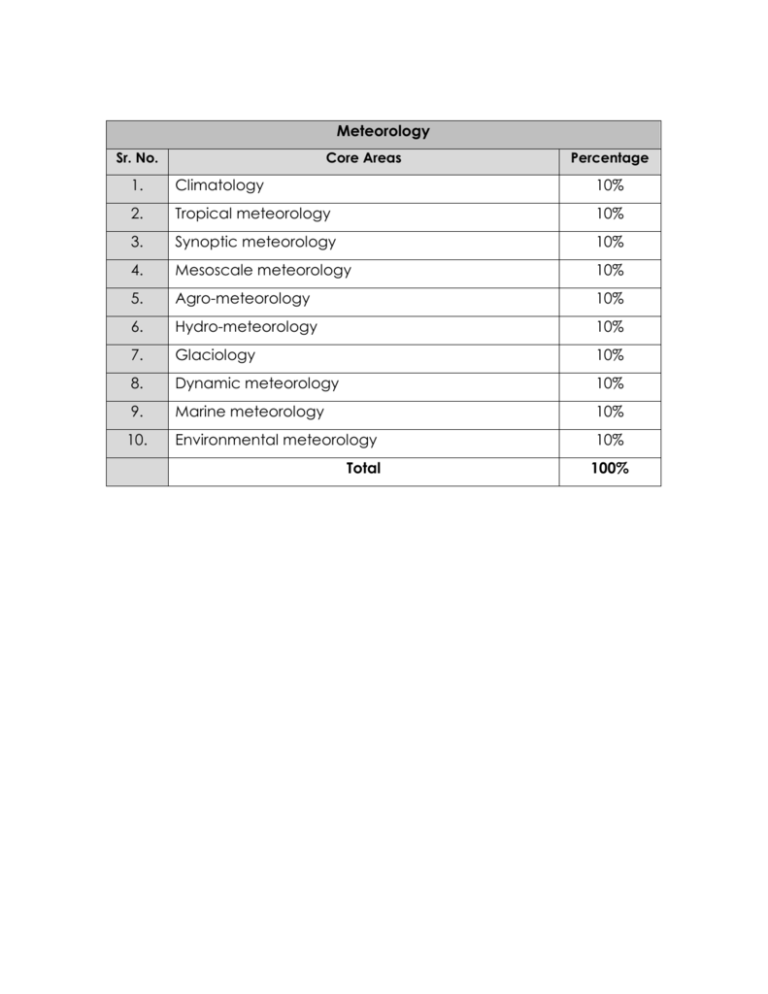
Meteorology Sr. No. Core Areas Percentage 1. Climatology 10% 2. Tropical meteorology 10% 3. Synoptic meteorology 10% 4. Mesoscale meteorology 10% 5. Agro-meteorology 10% 6. Hydro-meteorology 10% 7. Glaciology 10% 8. Dynamic meteorology 10% 9. Marine meteorology 10% 10. Environmental meteorology 10% Total 100% Meteorology (Detailed) Sr. No. 1. 2. Core Areas CLIMATOLOGY: i. Introduction to Weather & Climate ii. Climate Change / Variability and Global Warming iii. Components of Climate System iv. Climate Classification, Climate of Pakistan v. Global energy budget vi. Weather and Climate Models vii. Climate Change Assessment and Prediction viii. Emission & Climate Scenarios ix. Green House Gases x. Natural and Anthropogenic Causes of CC xi. Introduction to Glaciers xii. Snow and Ice xiii. Snowline and Temperature xiv. Factors affecting climate of a region xv. Introduction to Paleoclimatology and Dandrochronology xvi. Ice Age TROPICAL METEOROLOGY: i. Global General Circulation ii. Composition and Structure of Atmosphere iii. Introduction to Atmospheric Thermodynamics iv. Monsoon circulation v. Sea and Land Breezes vi. Tropical Weather Systems vii. Tropical Cyclones viii. Inter-Tropical Convergence Zone (ITCZ) ix. Coriolis force x. Jet streams xi. Cloud Types xii. Different forms of Precipitation xiii. Characteristics of hot and cold air Percentage 10% 10% xiv. 3. 4. Role of Land and Sea in weather changes SYNOPTIC METEOROLOGY: i. Weather systems ii. Upper Atmosphere circulations iii. Synoptic Weather charts iv. Types and Characteristics of Air Masses v. Atmospheric Waves vi. Fronts and their Types vii. Frontogenesis and frontolysis viii. Geostrophic winds ix. Thermal Winds x. Absolute, Specific and Relative Humidity, Dew Point, Vapour Pressure xi. Evaporation, condensation & Precipitation xii. Weather Radars and Satellites xiii. Introduction to Numerical Weather Prediction MESOSCALE METEOROLOGY: i. Convection and Radiation ii. Clouds and Aerosols iii. Cloud Physics iv. Vorticity and Circulation v. Stability and instability of atmosphere vi. Alpha, Beta and Gamma Mesoscales Thermodynamic Processes in Atmosphere vii. Lightening and its mechanism viii. Mountain Waves ix. Inversion Layer x. Squall line, Gale Winds, Sleet, Dry line xi. Thunderstorm, Dust storm, Tornadoes, Doldrums, Ozone and Ozone Layer xii. Characteristics of Low and High Pressure xiii. Introduction to Troughs and Ridges xiv. Topographic Impacts xv. Slope winds and valley winds xvi. Warm and Cold Advection 10% 10% 5. 6. AGRO-METEOROLOGY: i. Agrometeorological Classification of Pakistan ii. Growth and Development of Plants iii. Effects of Abnormal Weather Conditions on Crops iv. Types of Evapotranspiration v. Water Balance vi. Capillary action and Osmatic Pressure vii. Growing Degree Days viii. Growing Season Length ix. Crop Water Demand x. Atmospheric Water Demand xi. Soil Moisture and Soil Temperature xii. Old and modern irrigation Techniques xiii. Fertility of Soil xiv. Types of Soil xv. Field Capacity, Permanent Wilting Point xvi. Photosynthesis xvii. Water Conservation xviii. Rain Water Harvesting HYDRO-METEOROLOGY: i. Hydrological Cycle ii. Light, Moderate, Heavy Rain & Cloudburst iii. Flood and Drought iv. Flash Floods, Riverine Floods and Rain Floods v. Water and river flow (Fluid Dynamics) vi. River Catchments and Runoff vii. Irrigation System viii. Return Period ix. Discharge Rate, Peak Flow, Dead Level of Dam, Sedimentation and Siltation x. Introduction to Remote Sensing & GIS xi. Intensity of Rainfall 10% 10% 7. 8. 9. GLACIOLOGY: i. Introduction to Glaciers, Glacial Ice Transformation from Snow to ice ii. Types of Glaciers iii. Glacial Mass balance iv. Effect of Debris Cover on Melting Process v. Snow, Ice and Surface Albedo vi. Response of Glaciers to Climate Change vii. Glacier Surges and Retreat viii. Ice Sheets and earth system ix. Ice Cores and Paleo-Cryology x. Glacial Lake Outburst Floods xi. Effect of pollution on Melting xii. Cryospheric Thermal Inversion DYNAMIC METEOROLOGY: i. Scale and Laws of Atmospheric Motions ii. Laws of Conservation of Mass, Energy and Momentum iii. Lapse Rates, Density of Atmosphere iv. Hydrostatics and Non-hydrostatics v. Numerical and Statistical Models vi. Adiabatic and non-Adiabatic process vii. Fluid Dynamics and Force of Friction viii. Turbulent Forces ix. Laminar Flow and Vertical Velocity x. Hot Air and Cold Air Characteristics xi. Convective Meso-scale Cells MARINE METEOROLOGY: i. Oceanic Circulation ii. Oceanic Currents iii. Sea surface temperature iv. El~Nino/La~Nina and Southern Oscillation Index v. Warm and Cold Pools vi. Tides and oceanic waves vii. Sea Level Rise viii. Cyclones, Typhones, Hurricanes (Definition, Naming) ix. Tsunami, Storm Surge 10% 10% 10% 10. ENVIRONMENTAL METEOROLOGY: i. Environment ii. Environmental Pollution (Air, Water and Soil) iii. Green House Gases (GHGs) iv. Green House Effect v. Natural and Anthropogenic Influences vi. GHG Emissions vii. Natural Disasters viii. Disaster Risk Reduction ix. Mitigation and Adaptation Measures x. Future Climate Projections Total 10% 100%

